Cosmology is the scientific study of the large scale properties of the Universe as a whole. It endeavors to use the scientific method to understand the origin, evolution and ultimate fate of the entire Universe. Like any field of science, cosmology involves the formation of theories or hypotheses about the universe which make specific predictions for phenomena that can be tested with observations. Depending on the outcome of the observations, the theories will need to be abandoned, revised or extended to accommodate the data. The prevailing theory about the origin and evolution of our Universe is the so-called Big Bang theory discussed at length in the pages linked in the left column. This primer in cosmological concepts is organized as follows:
Big Bang Cosmology
The Big Bang Model is a broadly accepted theory for the origin and evolution of our universe. It postulates that 12 to 14 billion years ago, the portion of the universe we can see today was only a few millimeters across. It has since expanded from this hot dense state into the vast and much cooler cosmos we currently inhabit. We can see remnants of this hot dense matter as the now very cold cosmic microwave background radiation which still pervades the universe and is visible to microwave detectors as a uniform glow across the entire sky.
FOUNDATIONS OF THE BIG BANG MODEL
The Big Bang Model rests on two theoretical pillars:
General Relativity
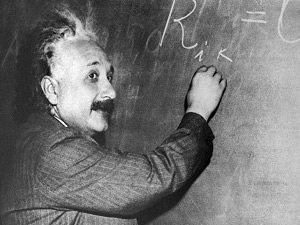 The first key idea dates to 1916 when Einstein developed his General Theory of Relativity which he proposed as a new theory of gravity. His theory generalizes Isaac Newton's original theory of gravity, c. 1680, in that it is supposed to be valid for bodies in motion as well as bodies at rest. Newton's gravity is only valid for bodies at rest or moving very slowly compared to the speed of light (usually not too restrictive an assumption!). A key concept of General Relativity is that gravity is no longer described by a gravitational "field" but rather it is supposed to be a distortion of space and time itself. Physicist John Wheeler put it well when he said "Matter tells space how to curve, and space tells matter how to move." Originally, the theory was able to account for peculiarities in the orbit of Mercury and the bending of light by the Sun, both unexplained in Isaac Newton's theory of gravity. In recent years, the theory has passed a series of rigorous tests.
The first key idea dates to 1916 when Einstein developed his General Theory of Relativity which he proposed as a new theory of gravity. His theory generalizes Isaac Newton's original theory of gravity, c. 1680, in that it is supposed to be valid for bodies in motion as well as bodies at rest. Newton's gravity is only valid for bodies at rest or moving very slowly compared to the speed of light (usually not too restrictive an assumption!). A key concept of General Relativity is that gravity is no longer described by a gravitational "field" but rather it is supposed to be a distortion of space and time itself. Physicist John Wheeler put it well when he said "Matter tells space how to curve, and space tells matter how to move." Originally, the theory was able to account for peculiarities in the orbit of Mercury and the bending of light by the Sun, both unexplained in Isaac Newton's theory of gravity. In recent years, the theory has passed a series of rigorous tests.
The Cosmological Principle
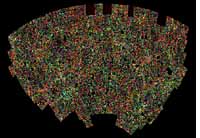 After the introduction of General Relativity a number of scientists, including Einstein, tried to apply the new gravitational dynamics to the universe as a whole. At the time this required an assumption about how the matter in the universe was distributed. The simplest assumption to make is that if you viewed the contents of the universe with sufficiently poor vision, it would appear roughly the same everywhere and in every direction. That is, the matter in the universe is homogeneous and isotropic when averaged over very large scales. This is called the Cosmological Principle. This assumption is being tested continuously as we actually observe the distribution of galaxies on ever larger scales. The accompanying picture shows how uniform the distribution of measured galaxies is over a 30° swath of the sky. In addition the cosmic microwave background radiation, the remnant heat from the Big Bang, has a temperature which is highly uniform over the entire sky. This fact strongly supports the notion that the gas which emitted this radiation long ago was very uniformly distributed.
After the introduction of General Relativity a number of scientists, including Einstein, tried to apply the new gravitational dynamics to the universe as a whole. At the time this required an assumption about how the matter in the universe was distributed. The simplest assumption to make is that if you viewed the contents of the universe with sufficiently poor vision, it would appear roughly the same everywhere and in every direction. That is, the matter in the universe is homogeneous and isotropic when averaged over very large scales. This is called the Cosmological Principle. This assumption is being tested continuously as we actually observe the distribution of galaxies on ever larger scales. The accompanying picture shows how uniform the distribution of measured galaxies is over a 30° swath of the sky. In addition the cosmic microwave background radiation, the remnant heat from the Big Bang, has a temperature which is highly uniform over the entire sky. This fact strongly supports the notion that the gas which emitted this radiation long ago was very uniformly distributed.
These two ideas form the entire theoretical basis for Big Bang cosmology and lead to very specific predictions for observable properties of the universe. An overview of the Big Bang Model is presented in a set of companion pages.
Foundations of Big Bang Cosmology
The Big Bang model of cosmology rests on two key ideas that date back to the early 20th century: General Relativity and the Cosmological Principle. By assuming that the matterin the universe is distributed uniformly on the largest scales, one can use General Relativity to compute the corresponding gravitational effects of that matter. Since gravity is a property of space-time in General Relativity, this is equivalent to computing the dynamics of space-time itself. The story unfolds as follows:
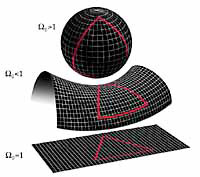 Given the assumption that the matter in the universe is homogeneous and isotropic (The Cosmological Principle) it can be shown that the corresponding distortion of space-time (due to the gravitational effects of this matter) can only have one of three forms, as shown schematically in the picture at left. It can be "positively" curved like the surface of a ball and finite in extent; it can be "negatively" curved like a saddle and infinite in extent; or it can be "flat" and infinite in extent - our "ordinary" conception of space. A key limitation of the picture shown here is that we can only portray the curvature of a 2-dimensional plane of an actual 3-dimensional space! Note that in a closed universe you could start a journey off in one direction and, if allowed enough time, ultimately return to your starting point; in an infinite universe, you would never return.
Given the assumption that the matter in the universe is homogeneous and isotropic (The Cosmological Principle) it can be shown that the corresponding distortion of space-time (due to the gravitational effects of this matter) can only have one of three forms, as shown schematically in the picture at left. It can be "positively" curved like the surface of a ball and finite in extent; it can be "negatively" curved like a saddle and infinite in extent; or it can be "flat" and infinite in extent - our "ordinary" conception of space. A key limitation of the picture shown here is that we can only portray the curvature of a 2-dimensional plane of an actual 3-dimensional space! Note that in a closed universe you could start a journey off in one direction and, if allowed enough time, ultimately return to your starting point; in an infinite universe, you would never return.
Before we discuss which of these three pictures describe our universe (if any) we must make a few disclaimers:
- Because the universe has a finite age (~13.7 billion years) we can only see a finite distance out into space: ~13.7 billion light years. This is our so-called horizon. The Big Bang Model does not attempt to describe that region of space significantly beyond our horizon - space-time could well be quite different out there.
- It is possible that the universe has a more complicated global topology than that which is portrayed here, while still having the same local curvature. For example it could have the shape of a torus (doughnut). There may be some ways to test this idea, but most of the following discussion is unaffected.
Matter plays a central role in cosmology. It turns out that the average density of matter uniquely determines the geometry of the universe (up to the limitations noted above). If the density of matter is less than the so-called critical density, the universe is open and infinite. If the density is greater than the critical density the universe is closed and finite. If the density just equals the critical density, the universe is flat, but still presumably infinite. The value of the critical density is very small: it corresponds to roughly 6 hydrogen atoms per cubic meter, an astonishingly good vacuum by terrestrial standards! One of the key scientific questions in cosmology today is: what is the average density of matter in our universe? While the answer is not yet known for certain, it appears to be tantalizingly close to the critical density.
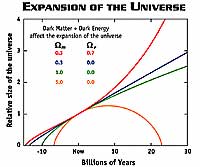 Given a law of gravity and an assumption about how the matter is distributed, the next step is to work out the dynamics of the universe - how space and the matter in it evolves with time. The details depend on some further information about the matter in the universe, namely its density (mass per unit volume) and its pressure (force it exerts per unit area), but the generic picture that emerges is that the universe started from a very small volume, an event later dubbed the Big Bang, with an initial expansion rate. For the most part this rate of expansion has been slowing down (decelerating) ever since due to the gravitational pull of the matter on itself. A key question for the fate of the universe is whether or not the pull of gravity is strong enough to ultimately reverse the expansion and cause the universe to collapse back on itself. In fact, recent observations have raised the possibility that the expansion of the universe might in fact be speeding up (accelerating), raising the possibility that the evolution of the universe is now dominated by a bizarre form of matter which has a negative pressure.
Given a law of gravity and an assumption about how the matter is distributed, the next step is to work out the dynamics of the universe - how space and the matter in it evolves with time. The details depend on some further information about the matter in the universe, namely its density (mass per unit volume) and its pressure (force it exerts per unit area), but the generic picture that emerges is that the universe started from a very small volume, an event later dubbed the Big Bang, with an initial expansion rate. For the most part this rate of expansion has been slowing down (decelerating) ever since due to the gravitational pull of the matter on itself. A key question for the fate of the universe is whether or not the pull of gravity is strong enough to ultimately reverse the expansion and cause the universe to collapse back on itself. In fact, recent observations have raised the possibility that the expansion of the universe might in fact be speeding up (accelerating), raising the possibility that the evolution of the universe is now dominated by a bizarre form of matter which has a negative pressure.
The picture above shows a number of possible scenarios for the relative size of the universe vs. time: the bottom (green) curve represents a flat, critical density universe in which the expansion rate is continually slowing down (the curves becomes ever more horizontal). The middle (blue) curve shows an open, low density universe whose expansion is also slowing down, but not as much as the critical density universe because the pull of gravity is not as strong. The top (red) curve shows a universe in which a large fraction of its mass/energy maybe in the very vacuum of space itself, known as the "cosmological constant", a leading candidate for the so-called "dark energy" which is causing the expansion of the universe to speed up (accelerate). There is growing evidence that our universe is following the red curve.
Please keep in mind the following important points to avoid misconceptions about the Big Bang and expansion:
- The Big Bang did not occur at a single point in space as an "explosion." It is better thought of as the simultaneous appearance of space everywhere in the universe. That region of space that is within our present horizon was indeed no bigger than a point in the past. Nevertheless, if all of space both inside and outside our horizon is infinite now, it was born infinite. If it is closed and finite, then it was born with zero volume and grew from that. In neither case is there a "center of expansion" - a point from which the universe is expanding away from. In the ball analogy, the radius of the ball grows as the universe expands, but all points on the surface of the ball (the universe) recede from each other in an identical fashion. The interior of the ball should not be regarded as part of the universe in this analogy.
- By definition, the universe encompasses all of space and time as we know it, so it is beyond the realm of the Big Bang model to postulate what the universe is expanding into. In either the open or closed universe, the only "edge" to space-time occurs at the Big Bang (and perhaps its counterpart the Big Crunch), so it is not logically necessary (or sensible) to consider this question.
- It is beyond the realm of the Big Bang Model to say what gave rise to the Big Bang. There are a number of speculative theories about this topic, but none of them make realistically testable predictions as of yet.
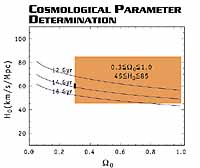 To this point, the only assumption we have made about the universe is that its matter is distributed homogeneously and isotropically on large scales. There are a number of free parameters in this family of Big Bang models that must be fixed by observations of our universe. The most important ones are: the geometry of the universe (open, flat or closed); the present expansion rate (the Hubble constant); the overall course of expansion, past and future, which is determined by the fractional density of the different types of matter in the universe. Note that the present age of the universe follows from the expansion history and present expansion rate.
To this point, the only assumption we have made about the universe is that its matter is distributed homogeneously and isotropically on large scales. There are a number of free parameters in this family of Big Bang models that must be fixed by observations of our universe. The most important ones are: the geometry of the universe (open, flat or closed); the present expansion rate (the Hubble constant); the overall course of expansion, past and future, which is determined by the fractional density of the different types of matter in the universe. Note that the present age of the universe follows from the expansion history and present expansion rate.
As noted above, the geometry and evolution of the universe are determined by the fractional contribution of various types of matter. Since both energy density and pressure contribute to the strength of gravity in General Relativity, cosmologists classify types of matter by its "equation of state" the relationship between its pressure and energy density. The basic classification scheme is:
- Radiation: composed of massless or nearly massless particles that move at the speed of light. Known examples include photons (light) and neutrinos. This form of matter is characterized by having a large positive pressure.
- Baryonic matter: this is "ordinary matter" composed primarily of protons, neutrons and electrons. This form of matter has essentially no pressure of cosmological importance.
- Dark matter: this generally refers to "exotic" non-baryonic matter that interacts only weakly with ordinary matter. While no such matter has ever been directly observed in the laboratory, its existence has long been suspected for reasons discussed in a subsequent page. This form of matter also has no cosmologically significant pressure.
- Dark energy: this is a truly bizarre form of matter, or perhaps a property of the vacuum itself, that is characterized by a large, negative pressure. This is the only form of matter that can cause the expansion of the universe to accelerate, or speed up.
One of the central challenges in cosmology today is to determine the relative and total densities (energy per unit volume) in each of these forms of matter, since this is essential to understanding the evolution and ultimate fate of our universe
Tests of Big Bang: Expansion
Edwin Hubble
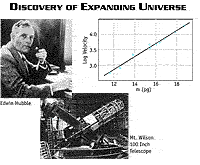 The Big Bang model was a natural outcome of Einstein's General Relativity as applied to a homogeneous universe. However, in 1917, the idea that the universe was expanding was thought to be absurd. So Einstein invented the cosmological constant as a term in his General Relativity theory that allowed for a static universe. In 1929, Edwin Hubble announced that his observations of galaxies outside our own Milky Way showed that they were systematically moving away from us with a speed that was proportional to their distance from us. The more distant the galaxy, the faster it was receding from us. The universe was expanding after all, just as General Relativity originally predicted! Hubble observed that the light from a given galaxy was shifted further toward the red end of the light spectrum the further that galaxy was from our galaxy.
The Big Bang model was a natural outcome of Einstein's General Relativity as applied to a homogeneous universe. However, in 1917, the idea that the universe was expanding was thought to be absurd. So Einstein invented the cosmological constant as a term in his General Relativity theory that allowed for a static universe. In 1929, Edwin Hubble announced that his observations of galaxies outside our own Milky Way showed that they were systematically moving away from us with a speed that was proportional to their distance from us. The more distant the galaxy, the faster it was receding from us. The universe was expanding after all, just as General Relativity originally predicted! Hubble observed that the light from a given galaxy was shifted further toward the red end of the light spectrum the further that galaxy was from our galaxy.
The Hubble Constant
 The specific form of Hubble's expansion law is important: the speed of recession is proportional to distance. The expanding raisin bread model at left illustrates why this is important. If every portion of the bread expands by the same amount in a given interval of time, then the raisins would recede from each other with exactly a Hubble type expansion law. In a given time interval, a nearby raisin would move relatively little, but a distant raisin would move relatively farther - and the same behavior would be seen from any raisin in the loaf. In other words, the Hubble law is just what one would expect for a homogeneous expanding universe, as predicted by the Big Bang theory. Moreover no raisin, or galaxy, occupies a special place in this universe - unless you get too close to the edge of the loaf where the analogy breaks down.
The specific form of Hubble's expansion law is important: the speed of recession is proportional to distance. The expanding raisin bread model at left illustrates why this is important. If every portion of the bread expands by the same amount in a given interval of time, then the raisins would recede from each other with exactly a Hubble type expansion law. In a given time interval, a nearby raisin would move relatively little, but a distant raisin would move relatively farther - and the same behavior would be seen from any raisin in the loaf. In other words, the Hubble law is just what one would expect for a homogeneous expanding universe, as predicted by the Big Bang theory. Moreover no raisin, or galaxy, occupies a special place in this universe - unless you get too close to the edge of the loaf where the analogy breaks down.
The current WMAP results show the Hubble Constant to be 73.5 +/-3.2 (km/sec)/Mpc. If the WMAP data is combined with other cosmological data, the best estimate is 70.8 +/- 1.6 (km/sec)/Mpc.
Tests of Big Bang: The Light Elements
NUCLEOSYNTHESIS IN THE EARLY UNIVERSE
The term nucleosynthesis refers to the formation of heavier elements, atomic nuclei with many protons and neutrons, from the fusion of lighter elements. The Big Bang theory predicts that the early universe was a very hot place. One second after the Big Bang, the temperature of the universe was roughly 10 billion degrees and was filled with a sea of neutrons, protons, electrons, anti-electrons (positrons), photons and neutrinos. As the universe cooled, the neutrons either decayed into protons and electrons or combined with protons to make deuterium (an isotope of hydrogen). During the first three minutes of the universe, most of the deuterium combined to make helium. Trace amounts of lithium were also produced at this time. This process of light element formation in the early universe is called “Big Bang nucleosynthesis” (BBN).
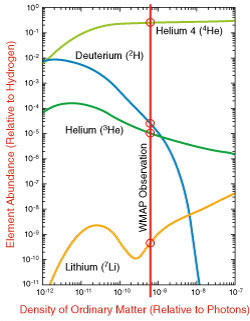 The predicted abundance of deuterium, helium and lithium depends on the density of ordinary matter in the early universe, as shown in the figure at left. These results indicate that the yield of helium is relatively insensitive to the abundance of ordinary matter, above a certain threshold. We generically expect about 24% of the ordinary matter in the universe to be helium produced in the Big Bang. This is in very good agreement with observations and is another major triumph for the Big Bang theory.
The predicted abundance of deuterium, helium and lithium depends on the density of ordinary matter in the early universe, as shown in the figure at left. These results indicate that the yield of helium is relatively insensitive to the abundance of ordinary matter, above a certain threshold. We generically expect about 24% of the ordinary matter in the universe to be helium produced in the Big Bang. This is in very good agreement with observations and is another major triumph for the Big Bang theory.
However, the Big Bang model can be tested further. Given a precise measurement of the abundance of ordinary matter, the predicted abundances of the other light elements becomes highly constrained. The WMAP satellite is able to directly measure the ordinary matter density and finds a value of 4.6% (±0.2%), indicated by the vertical red line in the graph. This leads to predicted abundances shown by the circles in the graph, which are in good agreement with observed abundances. This is an important and detailed test of nucleosynthesis and is further evidence in support of the Big Bang theory. Had the results been in conflict, it would point to 1) errors in the data, 2) an incomplete understanding of the process of Big Bang nucleosynthesis, 3) a misunderstanding of the mechanisms that produce fluctuations in the microwave background radiation, or 4) a more fundamental problem with the Big Bang theory.
NUCLEOSYNTHESIS IN STARS
Elements heavier than lithium are all synthesized in stars. During the late stages of stellar evolution, massive stars burn helium to carbon, oxygen, silicon, sulfur, and iron. Elements heavier than iron are produced in two ways: in the outer envelopes of super-giant stars and in the explosion of a supernovae. All carbon-based life on Earth is literally composed of stardust.
SOME HISTORY
In 1948, Physicist George Gamow hypothesized that all of the elements might have been made in the hot and dense early universe. He suggested to his student, Ralph Alpher, that he calculate this. Alpher did so for his PhD thesis, with Robert Herman participating in much of the work. Alpher and Herman found that Gamow was wrong: most elements could not have been made in the early universe. The problem is with neutron capture. Neutrons decay in about 10 minutes, and their density decreases as the universe expands in that time. There just isn't enough time to keep building up to the heavier elements before the neutrons are gone. The heavy elements are made later, in stars. Only the lightest elements are built up in the early universe. The important prediction that the cosmic microwave background (CMB) exists, and has a blackbody spectrum with a temperature of about 5 degrees above absolute zero, was a by-product of this work.
Tests of Big Bang: The CMB
The Big Bang theory predicts that the early universe was a very hot place and that as it expands, the gas within it cools. Thus the universe should be filled with radiation that is literally the remnant heat left over from the Big Bang, called the “cosmic microwave background radiation”, or CMB.
DISCOVERY OF THE COSMIC MICROWAVE BACKGROUND
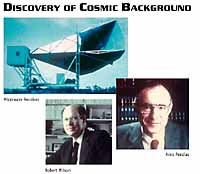 The existence of the CMB radiation was first predicted by Ralph Alpher, Robert Herman, and George Gamow in 1948, as part of their work on Big Bang Nucleosynthesis. It was first observed inadvertently in 1965 by Arno Penzias and Robert Wilson at the Bell Telephone Laboratories in Murray Hill, New Jersey. The radiation was acting as a source of excess noise in a radio receiver they were building. Coincidentally, researchers at nearby Princeton University, led by Robert Dicke and including Dave Wilkinson of the WMAP science team, were devising an experiment to find the CMB. When they heard about the Bell Labs result they immediately realized that the CMB had been found. The result was a pair of papers in the Astrophysical Journal (vol. 142 of 1965): one by Penzias and Wilson detailing the observations, and one by Dicke, Peebles, Roll, and Wilkinson giving the cosmological interpretation. Penzias and Wilson shared the 1978 Nobel prize in physics for their discovery.
The existence of the CMB radiation was first predicted by Ralph Alpher, Robert Herman, and George Gamow in 1948, as part of their work on Big Bang Nucleosynthesis. It was first observed inadvertently in 1965 by Arno Penzias and Robert Wilson at the Bell Telephone Laboratories in Murray Hill, New Jersey. The radiation was acting as a source of excess noise in a radio receiver they were building. Coincidentally, researchers at nearby Princeton University, led by Robert Dicke and including Dave Wilkinson of the WMAP science team, were devising an experiment to find the CMB. When they heard about the Bell Labs result they immediately realized that the CMB had been found. The result was a pair of papers in the Astrophysical Journal (vol. 142 of 1965): one by Penzias and Wilson detailing the observations, and one by Dicke, Peebles, Roll, and Wilkinson giving the cosmological interpretation. Penzias and Wilson shared the 1978 Nobel prize in physics for their discovery.
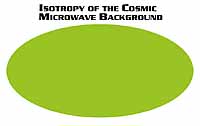 Today, the CMB radiation is very cold, only 2.725° above absolute zero, thus this radiation shines primarily in the microwave portion of the electromagnetic spectrum, and is invisible to the naked eye. However, it fills the universe and can be detected everywhere we look. In fact, if we could see microwaves, the entire sky would glow with a brightness that was astonishingly uniform in every direction. The picture at left shows a false color depiction of the temperature (brightness) of the CMB over the full sky (projected onto an oval, similar to a map of the Earth). The temperature is uniform to better than one part in a thousand! This uniformity is one compelling reason to interpret the radiation as remnant heat from the Big Bang; it would be very difficult to imagine a local source of radiation that was this uniform. In fact, many scientists have tried to devise alternative explanations for the source of this radiation but none have succeeded.
Today, the CMB radiation is very cold, only 2.725° above absolute zero, thus this radiation shines primarily in the microwave portion of the electromagnetic spectrum, and is invisible to the naked eye. However, it fills the universe and can be detected everywhere we look. In fact, if we could see microwaves, the entire sky would glow with a brightness that was astonishingly uniform in every direction. The picture at left shows a false color depiction of the temperature (brightness) of the CMB over the full sky (projected onto an oval, similar to a map of the Earth). The temperature is uniform to better than one part in a thousand! This uniformity is one compelling reason to interpret the radiation as remnant heat from the Big Bang; it would be very difficult to imagine a local source of radiation that was this uniform. In fact, many scientists have tried to devise alternative explanations for the source of this radiation but none have succeeded.
WHY STUDY THE COSMIC MICROWAVE BACKGROUND?
Since light travels at a finite speed, astronomers observing distant objects are looking into the past. Most of the stars that are visible to the naked eye in the night sky are 10 to 100 light years away. Thus, we see them as they were 10 to 100 years ago. We observe Andromeda, the nearest big galaxy, as it was about 2.5 million years ago. Astronomers observing distant galaxies with the Hubble Space Telescope can see them as they were only a few billion years after the Big Bang. (Most cosmologists believe that the universe is between 12 and 14 billion years old.)
The CMB radiation was emitted only a few hundred thousand years after the Big Bang, long before stars or galaxies ever existed. Thus, by studying the detailed physical properties of the radiation, we can learn about conditions in the universe on very large scales, since the radiation we see today has traveled over such a large distance, and at very early times.
THE ORIGIN OF THE COSMIC MICROWAVE BACKGROUND
One of the profound observations of the 20th century is that the universe is expanding. This expansion implies the universe was smaller, denser and hotter in the distant past. When the visible universe was half its present size, the density of matter was eight times higher and the cosmic microwave background was twice as hot. When the visible universe was one hundredth of its present size, the cosmic microwave background was a hundred times hotter (273 degrees above absolute zero or 32 degrees Fahrenheit, the temperature at which water freezes to form ice on the Earth's surface). In addition to this cosmic microwave background radiation, the early universe was filled with hot hydrogen gas with a density of about 1000 atoms per cubic centimeter. When the visible universe was only one hundred millionth its present size, its temperature was 273 million degrees above absolute zero and the density of matter was comparable to the density of air at the Earth's surface. At these high temperatures, the hydrogen was completely ionized into free protons and electrons.
Since the universe was so very hot through most of its early history, there were no atoms in the early universe, only free electrons and nuclei. (Nuclei are made of neutrons and protons). The cosmic microwave background photons easily scatter off of electrons. Thus, photons wandered through the early universe, just as optical light wanders through a dense fog. This process of multiple scattering produces what is called a “thermal” or “blackbody” spectrum of photons. According to the Big Bang theory, the frequency spectrum of the CMB should have this blackbody form. This was indeed measured with tremendous accuracy by the FIRAS experiment on NASA's COBE satellite.
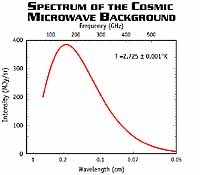 This figure shows the prediction of the Big Bang theory for the energy spectrum of the cosmic microwave background radiation compared to the observed energy spectrum. The FIRAS experiment measured the spectrum at 34 equally spaced points along the blackbody curve. The error bars on the data points are so small that they can not be seen under the predicted curve in the figure! There is no alternative theory yet proposed that predicts this energy spectrum. The accurate measurement of its shape was another important test of the Big Bang theory.
This figure shows the prediction of the Big Bang theory for the energy spectrum of the cosmic microwave background radiation compared to the observed energy spectrum. The FIRAS experiment measured the spectrum at 34 equally spaced points along the blackbody curve. The error bars on the data points are so small that they can not be seen under the predicted curve in the figure! There is no alternative theory yet proposed that predicts this energy spectrum. The accurate measurement of its shape was another important test of the Big Bang theory.
“SURFACE OF LAST SCATTERING”
Eventually, the universe cooled sufficiently that protons and electrons could combine to form neutral hydrogen. This was thought to occur roughly 400,000 years after the Big Bang when the universe was about one eleven hundredth its present size. Cosmic microwave background photons interact very weakly with neutral hydrogen.
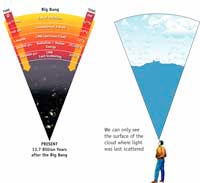 The behavior of CMB photons moving through the early universe is analogous to the propagation of optical light through the Earth's atmosphere. Water droplets in a cloud are very effective at scattering light, while optical light moves freely through clear air. Thus, on a cloudy day, we can look through the air out towards the clouds, but can not see through the opaque clouds. Cosmologists studying the cosmic microwave background radiation can look through much of the universe back to when it was opaque: a view back to 400,000 years after the Big Bang. This “wall of light“ is called the surface of last scattering since it was the last time most of the CMB photons directly scattered off of matter. When we make maps of the temperature of the CMB, we are mapping this surface of last scattering.
The behavior of CMB photons moving through the early universe is analogous to the propagation of optical light through the Earth's atmosphere. Water droplets in a cloud are very effective at scattering light, while optical light moves freely through clear air. Thus, on a cloudy day, we can look through the air out towards the clouds, but can not see through the opaque clouds. Cosmologists studying the cosmic microwave background radiation can look through much of the universe back to when it was opaque: a view back to 400,000 years after the Big Bang. This “wall of light“ is called the surface of last scattering since it was the last time most of the CMB photons directly scattered off of matter. When we make maps of the temperature of the CMB, we are mapping this surface of last scattering.
As shown above, one of the most striking features about the cosmic microwave background is its uniformity. Only with very sensitive instruments, such as COBE and WMAP, can cosmologists detect fluctuations in the cosmic microwave background temperature. By studying these fluctuations, cosmologists can learn about the origin of galaxies and large scale structures of galaxies and they can measure the basic parameters of the Big Bang theory.












